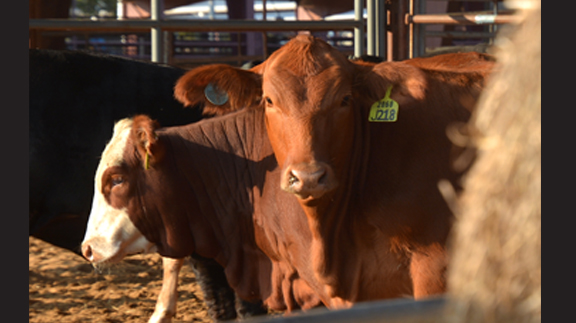Farm & Ranch
Amid historic-high cattle prices, producers can capture extra dollars

By: Blair Fannin
Writer: Blair Fannin, 979-845-2259, [email protected]
Contact: Dr. Levi Russell, 361-265-9203, [email protected]
BRENHAM – Though cattle prices have reached historic highs, there could be potential to make extra dollars and possibly add more young cows to a herd at current prices, according to a Texas A&M AgriLife Extension Service economist.
Dr. Levi Russell, AgriLife Extension economist in Corpus Christi, told attendees at the recent South Central Texas Cow-Calf Clinic in Brenham the cattle market has continued its historic price run due to supply constraints.
“Part of the reason for these high prices is low supply,” he said. “Overall, it doesn’t appear these prices are going to level off anytime soon due to the fact there are fewer beef cows out there.”
Russell said data indicates continued strong consumer demand, both domestically and for exports.
“This makes most folks think these high prices will continue to hold,” he said.
Prices for 700-pound to 800-pound steers in the first quarter of 2015 suggest $229 per hundredweight to $333 per hundredweight, according to Dr. David Anderson, AgriLife Extension livestock economist, College Station.
Those prices are expected to remain relatively steady throughout 2015 as more ranchers continue to slowly rebuild herds, Russell said.
Russell said simple management practices such as castrating calves can add more dollars to a rancher’s pocket.
“I want to emphasize there’s some real value in castrating your calves,” Russell said.
He said those who do not castrate will receive discounts up to 8 percent.
“Those who don’t choose to castrate would be better off selling those calves before they reach 600 pounds,” he said.
Russell also demonstrated the Bid Price Estimator for Beef Cows, a spreadsheet program that can assist beef cattle producers when deciding to buy replacement cattle. The program allows producers to input an expected rate of return against the net cash outlay for buying replacement cattle.
The spreadsheet takes into consideration annual operating costs as well as financing information.
“People are saying females are expensive to go out and buy right now,” Russell said. “But that net present value is what indicates your return on investment.”
To access the spreadsheet, visit http://bit.ly/1jOtkRj .
-30-
Farm & Ranch
Managing Show Cattle Through The Winter

By Heather Welper
Husband and wife duo, Heather and Calvin Welper, are the Co-Owners and Operators or Two C Livestock, located in Valley View, Texas.
The pair’s operation has a show cattle focus where they raise and sell purebred heifers of all breeds and club calf Hereford steers.
When it comes to show cattle, the Welpers know a thing or two including how to prepare for the cold winter months and the Texas major show season run.
To read more, pick up a copy of the November edition of North Texas Farm & Ranch magazine, available digitally and in print. To subscribe by mail, call 940-872-5922.

Farm & Ranch
Double M Ranch & Rescue

By Hannah Claxton, Editor
As the sun rises each day, so do the dozens of mouths that Meghan McGovern is responsible for getting fed. Rather than the sounds of a rooster crowing, McGovern hears the bellows and bleats of a variety of exotic deer, the chortle of kangaroos, the grunts of water buffaloes, and the chirps of a lemur.
Nestled against the banks of the Red River, the Double M Ranch and Rescue, with its high game fences and deer sprinkling the landscape,s its in stark contrast to the surrounding ranches.
“Having deer is kind of like eating potato chips- you can never actually have just one,” said McGovern with a laugh.
McGovern has several herds to take care of- fallow deer, axis deer, water buffalo, goats, and bison. In smaller numbers, there’s also a few kangaroos, a lemur, a potbelly pig, a pair of zebras, a watusi, and a few horses.
To read more, pick up a copy of the November edition of North Texas Farm & Ranch magazine, available digitally and in print. To subscribe by mail, call 940-872-5922.

Farm & Ranch
Acorn Toxicity

By Barry Whitworth, DVM, MPH
With the prolonged drought, most pastures in Oklahoma end up in poor condition. With the lack of available forage, animals may go in search of alternative foods.
If oak trees are in the pastures, acorns may be a favorite meal for some livestock in the fall. This may result in oak poisoning.
Oak leaves, twigs, buds, and acorns may be toxic to some animals when consumed.
To read more, pick up a copy of the November edition of North Texas Farm & Ranch magazine, available digitally and in print. To subscribe by mail, call 940-872-5922.

-

 Country Lifestyles2 years ago
Country Lifestyles2 years agoScott & Stacey Schumacher: A Growth Mindset
-

 Country Lifestyles8 years ago
Country Lifestyles8 years agoStyle Your Profile – What your style cowboy hat says about you and new trends in 2017
-

 HOME8 years ago
HOME8 years agoGrazing North Texas – Wilman Lovegrass
-

 Outdoor10 years ago
Outdoor10 years agoButtercup or Primrose?
-

 Country Lifestyles5 years ago
Country Lifestyles5 years agoAmber Crawford, Breakaway Roper
-

 Country Lifestyles9 years ago
Country Lifestyles9 years agoJune 2016 Profile – The man behind the mic: Bob Tallman
-

 Equine1 year ago
Equine1 year agoThe Will to Win
-

 Country Lifestyles8 years ago
Country Lifestyles8 years agoDecember 2016 Profile, Rusty Riddle – The Riddle Way




